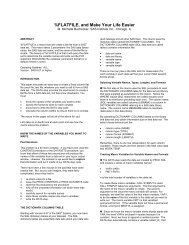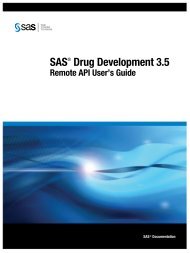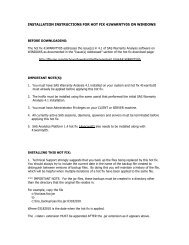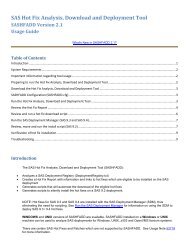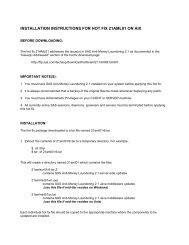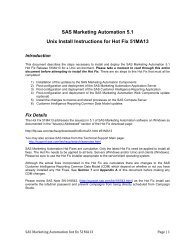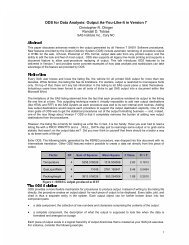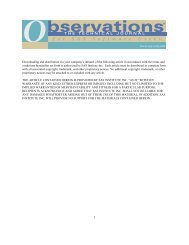SAS 9.3 Web Applications: Clustering - Index of - SAS
SAS 9.3 Web Applications: Clustering - Index of - SAS
SAS 9.3 Web Applications: Clustering - Index of - SAS
You also want an ePaper? Increase the reach of your titles
YUMPU automatically turns print PDFs into web optimized ePapers that Google loves.
Application Target<br />
<strong>SAS</strong>Themes<strong>9.3</strong> Do not target this application to any servers. Later tasks in this<br />
document describe how to deploy the <strong>Web</strong> application content to<br />
an HTTP server.<br />
<strong>SAS</strong><strong>Web</strong>Doc<strong>9.3</strong> This <strong>Web</strong> application can be clustered, but you might prefer to<br />
deploy it to the stand-alone server because it is not used by<br />
business users.<br />
<strong>SAS</strong><strong>Web</strong>ReportStudio4.3 Target all servers in the cluster.<br />
<strong>SAS</strong>WIPAdmin<strong>9.3</strong> This <strong>Web</strong> application can be clustered, but you might prefer to<br />
deploy it to the stand-alone server because it is not used by<br />
business users.<br />
<strong>SAS</strong><strong>Web</strong>InfrastructurePlatform<strong>Applications</strong><br />
<strong>9.3</strong><br />
Target all servers in the cluster.<br />
<strong>SAS</strong>WIPResources<strong>9.3</strong> Target all servers in the cluster.<br />
<strong>SAS</strong>ContentServer<strong>9.3</strong> Target all servers in the cluster.<br />
<strong>SAS</strong><strong>Web</strong>InfrastructurePlatformServices<strong>9.3</strong> Target all servers in the cluster.<br />
<strong>SAS</strong>Workflow<strong>9.3</strong> Target all servers in the cluster if you have performed the steps<br />
in “Reconfigure <strong>SAS</strong> Workflow” on page 9. Otherwise, target the<br />
stand-alone server.<br />
2 Select Manage Modules, and then select each check box for all the modules.<br />
3 From the Clusters and servers field, select the cluster or server instance, and<br />
then click Apply. The Server field for each module is updated with your choices.<br />
4 Click OK to target the application to the cluster or server.<br />
5 Repeat these steps for each <strong>SAS</strong> <strong>Web</strong> application to target the cluster or standalone<br />
server.<br />
6 Click Save to save the changes to the master configuration.<br />
Add <strong>SAS</strong>Cluster as a <strong>SAS</strong> Messaging Bus<br />
Member<br />
Add <strong>SAS</strong>Cluster as a <strong>SAS</strong> Messaging Bus Member 49<br />
The Events Generation Framework and <strong>SAS</strong> <strong>Web</strong> Infrastructure Platform need<br />
access to JMS resources. Adding the cluster as a member <strong>of</strong> the <strong>SAS</strong> Messaging<br />
Bus can provide high availability. The following steps describe how to add the cluster<br />
as a bus member, with a single messaging engine.<br />
One <strong>of</strong> the requirements for high availability is that the message store that is used by<br />
the messaging engine must be accessible by all the servers in the cluster. A JDBC<br />
data source can be used as a message store, or a file system location on network<br />
storage can be used as the message store. Before you begin this task, make sure





